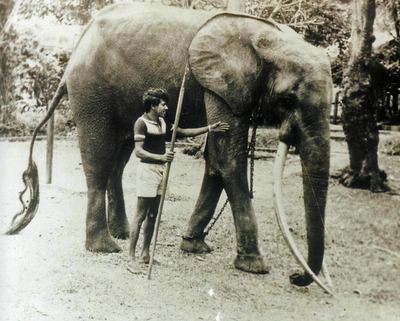It seems to me that some animals labeled as cyclotis do not show the distinctive characteristics. I recall an animal at Columbus, OH zoo that was said to be an African forest but might get by for a bush elephant. |
Thursday, April 08, 2010
From Richard Reynolds #1
Posted by
Buckles
at
4/08/2010 05:52:00 AM
![]()
Subscribe to:
Post Comments (Atom)






4 comments:
I goofed in suggesting that the African male Bud (also called Cosi) in Columbus,OH zoo was not cyclotis.
I saw him inside the pachyderm building in 1989. I just found my notes from that visit, but they say nothing beyond “African male,” a sad commentary on my powers of recognition. I copied the elephant data from the information board, and it said that Bud was born in “late 1971.”
Somehow, I later got the impression that his species status was questionable. That’s certainly insufficient evidence to take to court, as they say.
Now, Harry Peachy, Columbus zoo’s veteran and skilled pachyderm curator, has came forward in an e-mail earlier this week and set the record straight as follows - -
“Not sure why Richard would doubt Bud's status as a cyclotis. He had a broken tusk, so the confirmation of what remained could have been influenced by that break, as often happens. The remaining tusk was very straight, but did not point straight down - not a deal breaker. His overall size at 19 years of age was typical of a cyclotis male, and the sweep and shape of his ear was very consistent with cyclotis. He was imported out of Sierra Leone. He also looked very much like the cyclotis I saw in Garamba, who were the remnants of the group from Gangala na Bodio (sp?) the Belgian's training center in then-Zaire.” - Thanks, Harry"
I must add my thanks to Harry. Sierra Leone is (was) certainly cyclotis territory. Sadly, there are recent reports that all elephants in that terribly troubled country have been wiped out by poachers.
An elephant news web site says that Cosi (Bud) was imported from Sierra Leon in June 1972 by International Animal Exchange, Ferndale, MI (a Hunt Bros. operation), further, that he arrived at the Columbus zoo on June 19, 1972 and died there on November 10, 1991.
I wonder if anyone has a photo of Bud at Columbus.
Richard Reynolds, you are wonderfully amazing; I always look forward to your blog contributions and comments.
Paul Gutheil
The length of the tusks, as well as the tail hairs, are remarkable. One would think that normal living would have made such ivory an impediment to eating, fighting, etc., but apparently not. Or, are the animals shown here exceptional, in terms of the length of their ivory?
G'day All,
Unfortunately back in '91 or '92, Babar tripped and fell, braking off one of his tusks off at the lip and died from the infection several months later. He wasn't the brightest of elephants, but I am glad that I had a chance to spend time with him and all the other elephants at the Colombo Zoo, while living and helping out there on a couple visits!
Happy Days
Wayne
Post a Comment